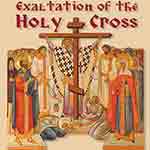14 September is the Feast of the Holy Cross, Holy Cross Day. In the spirit of Throwback Thursday, these are reflections preparing for Friday.
The 67-70 AD war of Jews against Romans ended with the Romans winning and the temple destroyed. Jerusalem lay in ruins.
Hadrian was born just after that, 76AD. He was the Roman emperor from 117 to 138. He rebuilt the Pantheon, and built “Hadrian’s Wall”, the northern limit of Britannia – areas of the island of Great Britain that were governed by the Roman Empire.
Hadrian is well known for his sensible approach to the illegal Christians.
He wanted to build a new Roman city on the ruins of Jerusalem: Aelia Capitolina. Maybe he originally thought of rebuilding the Jewish Temple and was advised against it because it might cause sedition. In any case, he built a temple to the Roman god Jupiter on the ruins of the Temple Mount instead. It is also understood he built a large temple to the goddess Venus over where Christ died and rose.
The Jewish reaction to building Jupiter’s temple on their holiest place led to another war with the Jews, and their dispersion.
Fast forward a couple of centuries and Christianity is now legal. You can imagine Christians having passed on the tradition of where Jesus died and rose. That was easy. “It is marked by the Temple to Venus.” When the now-Christian-affirming empire wanted to build a church on the spot where Jesus died and rose, that was where they went. The Church of the Resurrection was built in that place – now shared between a number of Christian denominations. St Helena, mother of the emperor Constantine, discovered the “true cross” there.
This Church of the Holy Sepulchre was dedicated on 14 September 335. Part of that ceremony involved bringing out the cross.
*****
The original Roman calendar was said to be invented by Romulus (753 BCE). It would have originally been a lunar calendar, with months starting on New Moon. Winter was not assigned to any month – the winter days were unaccounted for. The months were: Martius, Aprilis, Maius, Iunius, Quintilis, Sextilis, September, October, November, December. Full Moon falls half way through the month (the Ides). The Ides of September is close to the Fall Equinox (Northern Hemisphere) – the start of Autumn (Spring in the Southern Hemisphere).
The Rule of Benedict has (41:6)
Ab idus autem Septembres usque caput quadragesimae, ad nonam semper reficiant. From the thirteenth of September to the beginning of Lent, however, they are always to eat at None.
This is the start of “monastic Lent”.
From now until Easter, St Benedict has three nocturns of psalms and readings at Matins.
The Episcopal Church’s Book of Common Prayer (page 18) has “The Ember Days, traditionally observed on the Wednesdays, Fridays, and Saturdays after the First Sunday in Lent, the Day of Pentecost, Holy Cross Day, and December 13″. The mnemonic is “Lenty, Penty, Crucy, Lucy”.
These days can be associated with changes in the seasons. I have in the past also tried to discover if there are connections with our Jewish roots.
Yom Kippur, this year, begins on the evening of Tuesday, 18 September. Sukkot will be from the evening of Sunday, 23 September, to the evening of Sunday, 30 September.
As in Benedict’s Rule, we too might change our pace. In the Southern Hemisphere we can take on some of the Spring practices that our Northern Hemisphere siblings attach to Lent.
The Church of England provides a number of resource.
More reflections on the Feast of the Exaltation of the Holy Cross.
If you appreciated this post, consider signing up for a not-very-often email, and/or like the liturgy facebook page…




